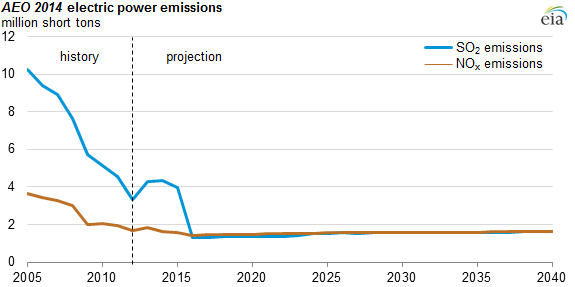
Coal-fired power plant operators consider emissions compliance strategies

Note: MATS stands for Mercury and Air Toxics Standards. FGD and DSI stand for flue gas desulfurization and dry sorbent injection, respectively. This chart does not include mercury control technologies such as ACI, which may also be an important MATS compliance strategy for some coal plants.
Note: Planned FGD includes 2,093 megawatts of planned equipment retrofits reported to EIA where the SO2 control technology type was not clearly specified.
Republished April 17, 2014, text was added to clarify graph.
Republished May 2, 2014, to correct an error in the graph.
Operators of coal-fired power plants throughout the United States are currently developing strategies to comply with the Environmental Protection Agency's (EPA) Mercury and Air Toxics Standards (MATS). The costs of the equipment needed to control acid and toxic metal emissions, such as flue gas desulfurization (FGD) and dry sorbent injection (DSI), play a significant role in retrofitting and retirement decisions faced by coal plant operators.
The MATS requires that coal-fired power plants incorporate the maximum achievable control technologies (MACT) in order to control the emissions of acid gases, toxic metals, and mercury by April 2015. The rule includes a provision that allows state environmental permitting agencies to grant one-year compliance exemptions. Many states are likely to use this flexibility.
At the end of 2012, 64.3% of the U.S. coal generating capacity in the electric power sector already had the appropriate environmental control equipment to comply with the MATS and allow their operation past 2016. Another 5.8% plan to add control equipment, while 9.5% have announced plans to retire. Owners of the remaining 20.4% are faced with the decision of upgrading or retiring their plants.
The three key pollutants targeted by the MATS have MACT compliance options that sometimes overlap.
- Acid gas. In most cases, a FGD or DSI system will qualify as the MACT for acid gases. Both of these systems can effectively remove sulfur dioxide (SO2) emissions as well. While not directly addressed by MATS, SO2 is regulated under Title IV of the Clean Air Act and the Clean Air Interstate Rule (CAIR). FGD systems are already installed on 63.7% of the U.S. coal fleet, while 0.6% have DSI systems.
- Toxic metals. FGD scrubbers with a fabric filter or an advanced electrostatic precipitator will likely qualify as the MACT for toxic metals. If a DSI system is used to control acid gases, then a fabric filter must be included to remove the appropriate level of toxic metals to complement the performance of the DSI system. The available equipment options are determined by the characteristics of each plant.
- Mercury. The control equipment needed to reduce mercury is driven by the type of coal burned and the plant configuration. In some cases an existing FGD scrubber and selective catalytic reduction system (SCR) can lower mercury emissions to the point where no additional controls are needed. In other cases, activated carbon injection (ACI) systems may be necessary to bring plants into compliance.
FGD scrubbers have higher capital costs but lower operating costs than DSI systems, along with a higher removal rate for SO2 and other acid gases (90% of SO2 emissions for FGD, compared to 70% for DSI). DSI systems have much lower capital costs than FGDs, but significantly higher operating costs because of the high cost of the reagent needed to remove emissions. This characteristic makes DSI systems more attractive for plants burning lower sulfur coal or for plants that operate infrequently. The low capital investment required for a DSI system makes it easier to recover the investment in the controls if the plant is not expected to operate frequently. Installation of a FGD scrubber would require the plant to operate more often in order to earn enough revenue to pay for the significant capital investment.
Implementation of the MATS will result in significant reductions in SO2 emissions from electric power plants. SO2 emissions from the electric power sector have already declined by 67% from 2005 through 2012. Nitrogen oxide (NOx) emissions from the electric power sector are projected to stay relatively flat through 2040 in the AEO2014 projection, as no specific national regulations driving their further reductions are currently enacted.

After a 68% decrease in annual SO2 emissions between 2015 and 2016, SO2 emissions are projected to rise slowly, at a 0.9% rate, from 2016 to 2040, while total electricity generation from coal-fired power plants rises at a 0.3% average annual rate post-2016. However, the annual SO2 emissions in 2040 are still projected to be 52% below 2012 levels.
NOx emissions stay relatively flat through 2040. Actions taken to comply with the MATS have a direct effect on SO2 emissions but not on NOx emissions. Annual NOx emissions resulting from the generation of electricity declined by 54% from 2005 to 2012, primarily in response to the implementation of the Clean Air Interstate Rule (CAIR) and the decline in coal-fired electricity generation over that time.
Principal contributor: Michael Leff
Tags: coal, electricity, emissions